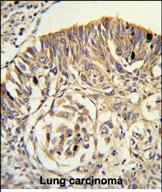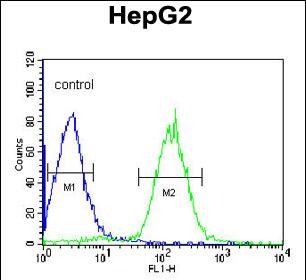PLTP Antibody (C-term)
Purified Rabbit Polyclonal Antibody (Pab)
- 产品详情
- 实验流程
- 背景知识
Application
| WB, IHC-P, FC, E |
|---|---|
| Primary Accession | P55058 |
| Reactivity | Human |
| Host | Rabbit |
| Clonality | Polyclonal |
| Isotype | Rabbit IgG |
| Calculated MW | 54739 Da |
| Antigen Region | 451-479 aa |
| Gene ID | 5360 |
|---|---|
| Other Names | Phospholipid transfer protein, Lipid transfer protein II, PLTP |
| Target/Specificity | This PLTP antibody is generated from rabbits immunized with a KLH conjugated synthetic peptide between 451-479 amino acids from the C-terminal region of human PLTP. |
| Dilution | WB~~1:1000 IHC-P~~1:100~500 FC~~1:10~50 E~~Use at an assay dependent concentration. |
| Format | Purified polyclonal antibody supplied in PBS with 0.09% (W/V) sodium azide. This antibody is prepared by Saturated Ammonium Sulfate (SAS) precipitation followed by dialysis against PBS. |
| Storage | Maintain refrigerated at 2-8°C for up to 2 weeks. For long term storage store at -20°C in small aliquots to prevent freeze-thaw cycles. |
| Precautions | PLTP Antibody (C-term) is for research use only and not for use in diagnostic or therapeutic procedures. |
| Name | PLTP |
|---|---|
| Function | Mediates the transfer of phospholipids and free cholesterol from triglyceride-rich lipoproteins (low density lipoproteins or LDL and very low density lipoproteins or VLDL) into high-density lipoproteins (HDL) as well as the exchange of phospholipids between triglyceride-rich lipoproteins themselves (PubMed:11013307, PubMed:19321130, PubMed:21515415, PubMed:29883800, PubMed:7654777, PubMed:9132017). Facilitates the transfer of a spectrum of different lipid molecules, including diacylglycerol, phosphatidic acid, sphingomyelin, phosphatidylcholine, phosphatidylinositol, phosphatidylglycerol, cerebroside and phosphatidyl ethanolamine (PubMed:9132017). Plays an important role in HDL remodeling which involves modulating the size and composition of HDL (PubMed:29883800). Also plays a key role in the uptake of cholesterol from peripheral cells and tissues that is subsequently transported to the liver for degradation and excretion (PubMed:21736953). Two distinct forms of PLTP exist in plasma: an active form that can transfer phosphatidylcholine from phospholipid vesicles to HDL, and an inactive form that lacks this capability (PubMed:11013307). |
| Cellular Location | Secreted. Nucleus. Note=Nuclear export is XPO1/CRM1- dependent. |
| Tissue Location | Widely expressed. Highest level of expression in the ovary, thymus and placenta, with moderate levels found in the pancreas, small intestine, testis, lung and prostrate. Low level expression in the kidney, liver and spleen, with very low levels found in the heart, colon, skeletal muscle, leukocytes and brain. Expressed in the cortical neurons. |
For Research Use Only. Not For Use In Diagnostic Procedures.
Provided below are standard protocols that you may find useful for product applications.
BACKGROUND
PLTP is one of at least two lipid transfer proteins found in human plasma. The protein transfers phospholipids from triglyceride-rich lipoproteins to high density lipoprotein (HDL). In addition to regulating the size of HDL particles, this protein may be involved in cholesterol metabolism.
REFERENCES
Moerland,M., Samyn,H. Arterioscler. Thromb. Vasc. Biol. 28 (7), 1277-1282 (2008)
Albers,J.J., Wolfbauer,G. Biochim. Biophys. Acta 1258 (1), 27-34 (1995)
终于等到您。ABCEPTA(百远生物)抗体产品。
点击下方“我要评价 ”按钮提交您的反馈信息,您的反馈和评价是我们最宝贵的财富之一,
我们将在1-3个工作日内处理您的反馈信息。
如有疑问,联系:0512-88856768 tech-china@abcepta.com.























 癌症的基本特征包括细胞增殖、血管生成、迁移、凋亡逃避机制和细胞永生等。找到癌症发生过程中这些通路的关键标记物和对应的抗体用于检测至关重要。
癌症的基本特征包括细胞增殖、血管生成、迁移、凋亡逃避机制和细胞永生等。找到癌症发生过程中这些通路的关键标记物和对应的抗体用于检测至关重要。 为您推荐一个泛素化位点预测神器——泛素化分析工具,可以为您的蛋白的泛素化位点作出预测和评分。
为您推荐一个泛素化位点预测神器——泛素化分析工具,可以为您的蛋白的泛素化位点作出预测和评分。 细胞自噬受体图形绘图工具为你的蛋白的细胞受体结合位点作出预测和评分,识别结合到自噬通路中的蛋白是非常重要的,便于让我们理解自噬在正常生理、病理过程中的作用,如发育、细胞分化、神经退化性疾病、压力条件下、感染和癌症。
细胞自噬受体图形绘图工具为你的蛋白的细胞受体结合位点作出预测和评分,识别结合到自噬通路中的蛋白是非常重要的,便于让我们理解自噬在正常生理、病理过程中的作用,如发育、细胞分化、神经退化性疾病、压力条件下、感染和癌症。








